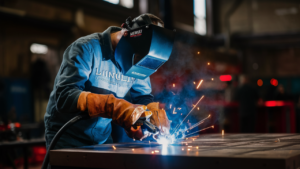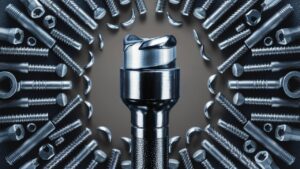Yes, you can TIG weld with a 110-volt welder, but it may limit your capabilities. These welders are suitable for thinner materials and lighter projects.
TIG welding is a precise technique that requires skill and the right equipment. Many hobbyists and professionals often wonder about the feasibility of using a 110-volt welder for TIG welding. While these machines are more common for MIG welding, they can handle TIG processes with some limitations.
Users should consider the material thickness and type of projects they plan to undertake. A 110-volt welder is ideal for small tasks, but it may struggle with thicker metals. Understanding the strengths and limitations of your equipment is crucial for achieving quality welds.
Introduction To Tig Welding
TIG welding, or Tungsten Inert Gas welding, is a popular method. It uses a non-consumable tungsten electrode. This method offers precise control over the weld. It is ideal for thin materials and intricate designs.
The Basics Of Tig Welding
TIG welding uses a combination of gas and electricity. Here are the main components:
- Tungsten Electrode: Produces the arc.
- Filler Material: Fills the joint.
- Inert Gas: Protects the weld from contamination.
The welder moves the torch manually. This requires skill and practice. TIG welding works on various metals, including:
| Metal Type | Common Applications |
|---|---|
| Aluminum | Aerospace parts, automotive components |
| Stainless Steel | Food processing, medical equipment |
| Carbon Steel | Structural applications, piping |
Advantages Of Tig Welding Over Other Methods
TIG welding has several advantages compared to other methods.
- High Quality: Produces clean and strong welds.
- Versatility: Works on many types of metals.
- Precision: Allows for accurate control over the weld puddle.
- Minimal Cleanup: Less spatter and slag.
This method is often preferred for delicate projects. It provides better aesthetics for visible welds. Welders appreciate the control it offers.
Understanding Electrical Requirements
Welding requires a solid understanding of electrical needs. Knowing how voltage, power, and amperage work helps you choose the right setup. This section explores these essential factors for TIG welding.
Voltage And Power In Welding
Voltage is the force that drives electric current. It is crucial in determining how effectively you can weld. Here are some key points:
- Typical Voltage for TIG Welding: 110V or 220V systems.
- Power Rating: Measured in watts (W).
- 110V Systems: Suitable for thin materials.
- 220V Systems: Ideal for thicker materials.
Check the power requirements of your TIG welder. A 110V system may limit your welding capabilities. Here’s a simple table comparing voltage and power:
| Voltage | Material Thickness | Power Output |
|---|---|---|
| 110V | Up to 1/8 inch | Lower power output |
| 220V | Up to 1/2 inch | Higher power output |
The Role Of Amperage In Welding
Amperage refers to the amount of electric current flowing. It plays a vital role in welding quality. Consider the following:
- Adjustable Amperage: Many TIG welders allow you to set this.
- Typical Range: 20 to 200 amps for TIG welding.
- Higher Amperage: Needed for thicker materials.
- Lower Amperage: Better for thinner materials.
Understanding amperage helps in achieving strong welds. Monitor it closely for optimal results.
110v Power Source
A 110V power source is common in many households. It provides enough energy for various tools and equipment. But can you TIG weld with it? Understanding 110V outlets helps answer this question.
Characteristics Of 110v Outlets
110V outlets have specific traits that make them unique:
- Typically found in residential homes.
- Standard voltage for small appliances.
- Usually protected by a 15 or 20-amp circuit breaker.
- Easy to access and widely available.
These characteristics make 110V outlets suitable for light welding tasks. They are not ideal for heavy-duty welding projects.
Common Applications For 110v In Welding
110V power is often used in specific welding applications:
- TIG welding for thin materials.
- Small DIY projects.
- Light-duty metal fabrication.
Many welders use 110V for home repairs and hobbies. It is not the best choice for professional work. Below is a table summarizing common uses:
| Application | Material Thickness | Welding Type |
|---|---|---|
| DIY Projects | Up to 1/8 inch | TIG |
| Home Repairs | Up to 3/16 inch | MIG |
| Hobby Welding | Up to 1/4 inch | Stick |
Understanding 110V applications helps determine if it suits your welding needs. Use it for lighter tasks. Choose higher voltage for heavy-duty welding.
Tig Welding With 110v
TIG welding is popular for its precision and control. Many ask, “Can you TIG weld with 110V?” This topic explores the feasibility and limitations of using a 110V power source for TIG welding.
Feasibility Of Tig Welding On 110v
Using a 110V power source for TIG welding is possible. Some machines are designed for this voltage. Here are key points:
- 110V machines are often portable.
- Ideal for light-duty jobs.
- Good for beginners and hobbyists.
Welders must choose the right machine. Some models can perform well on 110V.
Limitations And Considerations
While TIG welding on 110V is feasible, it has limitations:
| Limitation | Description |
|---|---|
| Power Output | 110V machines produce lower amperage. |
| Material Thickness | Not suitable for thick materials. |
| Duty Cycle | Lower duty cycle affects work time. |
Consider these factors before starting your project. Choose materials wisely. Use thin metals for better results.
Always check your machine’s specifications. Look for a model that meets your needs. This ensures quality welds and a smooth experience.
Equipment Selection For 110v Tig Welding
Choosing the right equipment is crucial for successful 110V TIG welding. This process requires specific tools to ensure quality and efficiency. Understanding what to select can save time and enhance results.
Choosing The Right Welder
Selecting a suitable TIG welder is essential for 110V projects. Here are some key features to consider:
- Power Output: Ensure it supports low-voltage operations.
- Duty Cycle: Look for a higher duty cycle for longer use.
- Portability: Choose a lightweight model for easy transport.
- Control Options: Adjustable settings improve welding quality.
| Welder Model | Power Output | Duty Cycle | Weight |
|---|---|---|---|
| Model A | 110A | 60% | 35 lbs |
| Model B | 120A | 80% | 40 lbs |
| Model C | 150A | 50% | 30 lbs |
Essential Accessories For Low-voltage Welding
Accessories enhance the performance of your TIG welder. Here are key items you should have:
- Electrodes: Use pure tungsten electrodes for better arc stability.
- Shielding Gas: Argon gas is ideal for most TIG welding tasks.
- Welding Gloves: Protect your hands from heat and sparks.
- Face Shield: A full-face shield keeps your face safe from UV rays.
- Welding Cart: Organize your tools and welder for easy transport.
Investing in quality accessories can greatly improve your welding experience. Proper equipment selection leads to better results and increased safety.
Techniques For Effective Tig Welding On 110v
TIG welding with a 110V machine presents unique challenges. Understanding effective techniques can enhance your results. Mastering these techniques can lead to better welds and improved skills.
Tips For Maintaining Arc Stability
Stable arcs are essential for quality TIG welding. Here are some tips:
- Use the Right Tungsten: Choose the correct tungsten size and type.
- Adjust Your Amperage: Set the amperage based on material thickness.
- Keep the Electrode Sharp: A sharp electrode helps maintain a stable arc.
- Maintain Correct Distance: Keep the tungsten 1/8 inch from the workpiece.
- Check Your Gas Flow: Ensure proper shielding gas flow to protect the weld.
Controlling Heat Input And Weld Pool
Controlling heat input is vital in TIG welding. Follow these strategies:
- Adjust Travel Speed: Move at a consistent speed to control heat.
- Use Weaving Techniques: Weave the torch for wider heat distribution.
- Monitor the Weld Pool: Observe the pool for signs of overheating.
- Practice Filler Rod Feeding: Feed the filler rod smoothly into the weld pool.
- Experiment with Pulse Settings: Use pulse settings for better heat management.
| Technique | Benefit |
|---|---|
| Correct Tungsten Size | Improves arc stability |
| Consistent Travel Speed | Prevents overheating |
| Weaving Motion | Distributes heat evenly |
| Monitoring Weld Pool | Ensures quality welds |
| Pulsed Welding | Reduces heat input |
Material Considerations
Choosing the right materials is crucial for successful 110V TIG welding. Different metals have unique properties. Understanding these properties helps achieve strong welds.
Types Of Metals Suitable For 110v Tig
Some metals work better with 110V TIG welding. Here are the most common:
- Aluminum: Lightweight and easy to weld.
- Stainless Steel: Offers great strength and corrosion resistance.
- Mild Steel: Affordable and widely available.
- Bronze: Excellent for artistic projects.
It’s important to choose the right filler rod. Match the filler rod to the base metal for strong welds.
Thickness And Joint Design
Metal thickness affects welding quality. Here are some points to consider:
| Thickness Range | Recommended Settings |
|---|---|
| 1/16″ to 1/8″ | Low amperage, quick travel speed |
| 1/8″ to 1/4″ | Medium amperage, steady travel speed |
| Over 1/4″ | Higher amperage, pre-heating may be needed |
Joint design influences weld strength. Consider these common types:
- Butt Joints: Simple alignment, but requires precise fit.
- T-Joints: Good for framing and supports.
- Corner Joints: Useful for boxes and enclosures.
Proper joint design and metal thickness ensure strong, durable welds.
Safety Precautions And Best Practices
Welding is an exciting skill, but safety comes first. Using a 110-volt TIG welder requires specific precautions. Following best practices protects you and others around you.
Personal Protective Equipment (ppe)
Wearing the right personal protective equipment is crucial. Ensure you have the following:
- Welding Helmet: Protects your eyes from bright light.
- Gloves: Use heat-resistant gloves to shield your hands.
- Apron: A leather apron protects your body from sparks.
- Boots: Wear steel-toed boots for foot protection.
- Respirator: Prevents inhalation of harmful fumes.
Inspect your PPE before use. Replace any damaged gear immediately. Proper gear minimizes injuries and enhances comfort.
Ensuring A Safe Welding Environment
A safe environment is vital for effective welding. Here are key points to consider:
- Clear the Area: Remove flammable materials.
- Ventilation: Ensure good airflow to reduce fumes.
- Lighting: Adequate lighting helps you see clearly.
- Fire Extinguisher: Keep one nearby for emergencies.
- First Aid Kit: Have one on hand for minor injuries.
Regularly check your workspace. Maintain organization to avoid accidents. Safe practices lead to better welding results.
Case Studies: Tig Welding With 110v In Action
TIG welding with 110V is gaining popularity. Many welders find it effective for various projects. This section explores real-life success stories and troubleshooting tips.
Real-life Success Stories
Several welders have successfully used 110V TIG machines. Here are some examples:
- Home Metal Art: A local artist created stunning sculptures. He used a 110V TIG welder to join stainless steel pieces.
- Automotive Repairs: A mechanic restored classic cars. He found 110V TIG welding perfect for thin sheet metal.
- Small Business: A welder opened a custom fabrication shop. He relied on a 110V machine for various projects.
These stories show that 110V TIG welding is versatile. Users achieve quality results without heavy equipment.
Troubleshooting Common Challenges
Welding with 110V can present challenges. Here are common issues and solutions:
| Challenge | Solution |
|---|---|
| Poor penetration | Adjust amperage and travel speed. |
| Inconsistent arc | Check torch and filler rod connections. |
| Overheating | Use a larger cooling system or pause between welds. |
For best results, keep these tips in mind:
- Use clean materials.
- Choose the right filler rod.
- Practice on scrap metal first.
With the right approach, 110V TIG welding can lead to great outcomes.

Frequently Asked Questions
Can You Use 110 Volts For Tig Welding?
Yes, you can use 110 volts for TIG welding. However, it limits the thickness of materials you can weld effectively. Most 110V TIG welders are suitable for thin metals, such as aluminum and stainless steel. For thicker materials, a higher voltage welder is recommended.
What Is The Best Tig Welder For 110 Volts?
The best TIG welder for 110 volts often depends on your specific needs. Popular choices include the AHP AlphaTIG 200X and the Everlast PowerTIG 160. These models offer versatility, reliability, and good performance for light to moderate welding tasks. Always consider your project requirements before making a purchase.
Is 110v Tig Welding Suitable For Beginners?
Yes, 110V TIG welding is suitable for beginners. These welders are generally easier to handle and set up. They are ideal for practicing techniques on thin metals. However, as skills improve, you may want to upgrade to a more powerful machine for advanced projects.
What Materials Can You Weld With A 110v Tig Welder?
A 110V TIG welder is best for thin materials. Common options include aluminum, stainless steel, and mild steel. These welders are not ideal for thicker metals, which require higher voltage for effective welding. Always check the specifications of your welder for material compatibility.
Conclusion
TIG welding with a 110V machine is possible, but it comes with limitations. Consider the materials and thickness you plan to work with. For beginners, a 110V TIG welder can be a practical choice. As your skills grow, you might want to invest in a more powerful machine for advanced projects.








